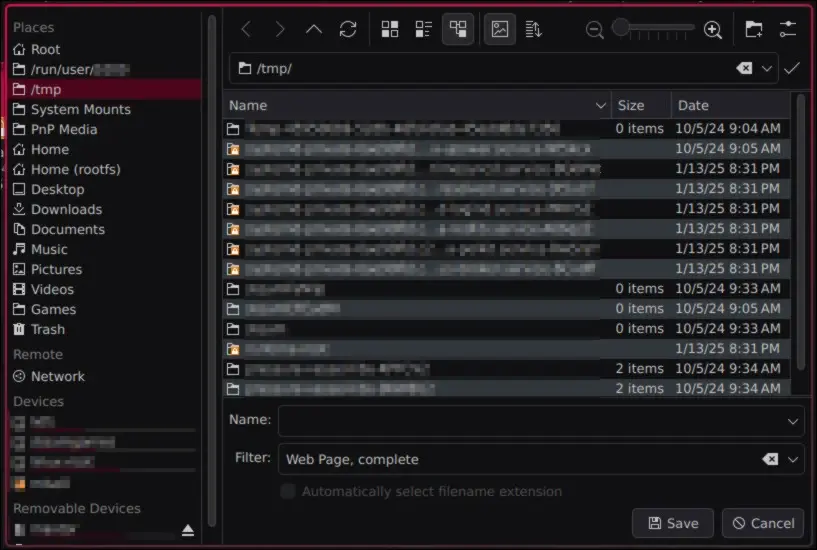What software have you found particularly frustrating or difficult to configure on Linux?
hostapd. I have no idea how you’re supposed to figure out the 50 or so options OpenWrt outputs for an AX card that I just ended up copying. And why doesn’t it detect those on its own?
Do VLANs with multiple wireless and wired clients using OPNSense and OpenWRT dummy APs count? Still haven’t quite figured it out.
Suspend with an Nvidia gpu
it’s embarrassing but for me it’s thinkfan. Instead I wrote my own solution in bash.
hyprland but I’m a noob
Motion on my RPI. I didn’t want it to save videos or photos, so I turned it off in the config. But it still saved them. So I tried a few other places in the config to turn it off, but nothing worked and I’d run out of space within a day. So I changed the save directory to /dev/null.
Then I tried to upgrade the pi, and the new version of motion has a different config, incompatible with the old one. So I’m running the old one.
XDG portal filechooser for Firefox: the KDE implementation uses Dolphin, which is full of features and I use most of them; the default GTK one is mildly infuriating to use and looks ugly too, but getting the browser to use the portal I want was a nightmare - especially since GTK discontinued the GTK_USE_PORTAL envvar.
The related Firefox config entries make no sense either.Can you explain a bit more about this and how to configure it? When I use FF on gnome, the save dialogue just looks like other dialogues?
I think GNOME’s filechooser is the GTK one (never used it so I’m not sure), mine looks like this:

It’s entirely possible that Firefox changed and now uses XDG portals by default, I configured it like this a long time ago.
As for how to configure it, I honestly don’t know.
It was a combination of messing withwidget.use-xdg-desktop-portalon about:config, and changing XDG envvars and dotfiles; both by following several conflicting Reddit and bbs.archlinux.org posts.
Just recently XDG Portals to get video sharing working. It just kept using the GTK fallbacks instead of KDE as I configured it, but it used the correct ones when starting from the terminal.
Eventually I figured out I had set an env override for
XDG_CURRENT_DESKTOP="sway"in my user systemd environment, because that’s what I used previously.Recently? Email notifications for my crontab jobs. I learned that snapraid sync had been failing for 200 DAYS. I was thinking it’d be easy for some reason. It hasn’t been.
Overall though, Nextcloud was a nightmare and I just gave up.
In recent years I’ve found NextCloud to reasonable. A little delicate initially, but once you have it working, the upgrades are very easy.
Setting up Alpine or Mutt with multiple SMTP accounts is an exercise in frustration.
Xserver… Somehow trying to find the magic string of letters and numbers that made your screen work.
Modeline ftw.
Multiple versions, paths, and installs of Python. Using pip makes it worse.
pyenv and pyenv-virtualenv together solves this for me. Virtualenv with specific python versions that work together well with other tools like pip or poetry.
It boils down to something like
$ pyenv install 3.12.7 $ pyenv virtualenv 3.12.7 myenv $ pyenv activate myenvand at that point you can do regular python stuff like pip installing etc.
I have limited Python experience, but I always thought that’s what virtualenvs and requirements.txt files are for? When I used those, I found it easy enough to use.
Cloud-init. The config yaml is rather straight forward, but I can’t convince my VM to execute it, and it’s driving me nuts.
I still don’t fully understand how to gracefully have multiple desktop environments and switch between them. When I want to try something new to me like lxqt, I usually spin up a VM.
Normally, the process is:
- install the packages for the desktop environment
- log out (not just locking the screen)
- find a dropdown or cogwheel where you can select the other desktop environment
- log in
Having said that, I don’t know what you mean with “graceful”. Desktop environments may involve lots of packages, which may create configuration files in your home directory or get auto-started in your other DEs, so it can be messy.
Something minimal, like LXQt or the various window managers, isn’t going to cause much of a mess, though.I guess, creating a second user with a separate home-directory, like the other person suggested, would isolate that potential mess…
Just add a new user
It used to be button 10 (also counting 4 scrollwheel directions and click) of my Elecom trackball. I had written a small C program reading the device node and writing the events just of that to stdout, then piping that to a tclsh script (so I could change it easily and it’s still super fast for gaming) which did something in X. Horrible. But then they added support for more buttons to everything (kernel, X) and now I can just map it in games, like any other.






